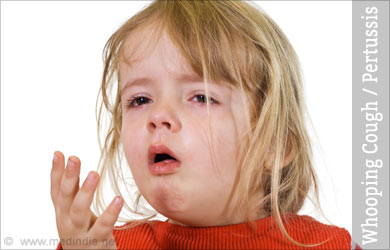- Johnston, Richard B. "Whooping Cough (Pertussis)." In Cecil Textbook of Medicine, 22nd ed. Edited by Lee Goldman et al. Philadelphia: Saunders, 2003, pp. 1829�30.
- Impact of Nasopharyngeal Swab Types on Detection of Bordetella pertussis by PCR and Culture. Joann L. Cloud, Weston Hymas, and Karen C. Carroll. J Clin Microbiol. 2002 October; 40(10): 3838�3840.10.1128/JCM.40.10.3838-3840.2002.
- Long, Sarah S. "Pertussis (Bordetella pertussis and B. parapertussis)." In Nelson Textbook of Pediatrics, 17th ed. Edited by Richard E. Behrman et al. Philadelphia: Saunders, 2003, pp. 908�11.
- Combined tetanus, diphtheria, and 5-component pertussis vaccine for use in adolescents and adults. Pichichero ME, Rennels MB, Edwards KM, et al. (June 2005). JAMA 293 (24): 3003�11. doi:10.1001/jama.293.24.3003. PMID 15933223.
- Acute Respiratory Infections in Children. Simoes EAF, Cherian T, Chow J, Shahid-Salles SA, Laxminarayan R, John TJ. In: Jamison DT, Breman JG, Measham AR, Alleyne G, Claeson M, Evans DB, Jha P, Mills A, Musgrove P, editors. Disease Control Priorities in Developing Countries. 2nd edition. Washington (DC): World Bank; 2006. Chapter 25. PMID: 21250360 [PubMed]
- Acellular vaccines for preventing whooping cough in children.Zhang L, Prietsch SO, Axelsson I, Halperin SA. Cochrane Database Syst Rev. 2011 Jan 19;1:CD001478.PMID: 21249646 [PubMed - in process]
About
Whooping cough is a respiratory tract infection caused by a bacterium called Bordetella pertussis. DPT vaccine helps to prevent the infection.
Whooping cough or pertussis is an acute respiratory tract infection caused by a bacterium called Bordetella pertussis, which causes uncontrolled episodes of persistent coughing. “Pertussis” also means “violent cough” and the Chinese call it “the cough of 100 days” because it lasts for a long duration.
In children, there is a sudden characteristic whooping sound while breathing in, following a coughing episode. This ‘whoop’ is however absent in adults and infants.
Facts about Whooping Cough:
- Whooping cough is prevalent in almost all countries especially the tropics.
- Children below 5 years are most affected which comprise of almost 90% of all cases. However, there is a recent increase in the adolescent age group.

- According to the Centers for disease control and prevention (CDC), the maximum number of whooping cough cases and half of the deaths due to whooping cough occur in children below 1 year.
- Whooping cough is a highly communicable disease with an attack rate of over 90%-100 % in non-immunized households.
- Whooping cough has a higher incidence in females with more fatality.
- Recovery from whooping cough or immunization helps to increase immunity. A mild second attack may occur in some cases..
- There is an increased incidence during winter and spring months due to overcrowding.
- There is also an increased incidence and exposure in a lower socioeconomic group because of living in unsanitary and overcrowded places.
- Whooping cough usually spreads by respiratory droplets infection from symptomatic infected individuals or by direct contact.
- The time for the disease to manifest once Bordetella pertussis infects a person ranges from 5-14 days but is usually 7-10 days.
- There is a steady increase in the cases of whooping cough globally especially in cases where there is no immunization.
The clinical course of the disease comprises of three stages, which are the catarrhal, the paroxysmal and the convalescent stages. The patient is diagnosed based on the clinical features and culture of bacteria from the nose and throat. Treatment includes antibiotics and supportive care. Whooping cough can be prevented by immunization with DPT vaccine.





